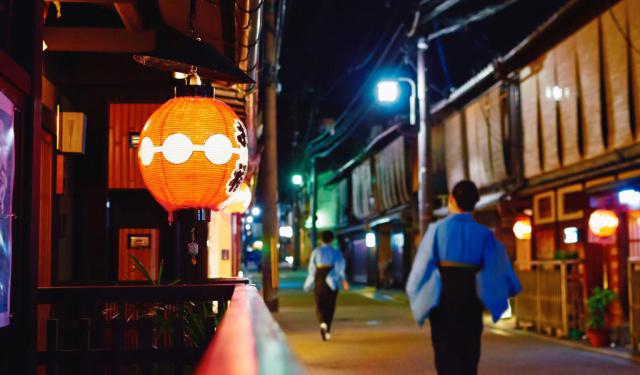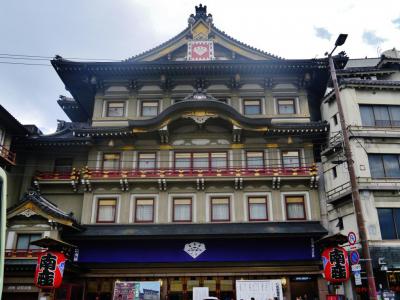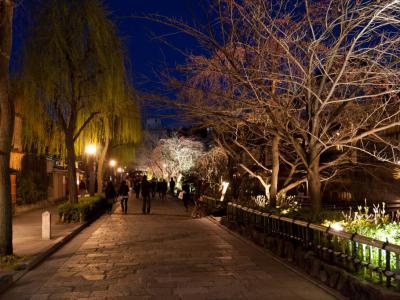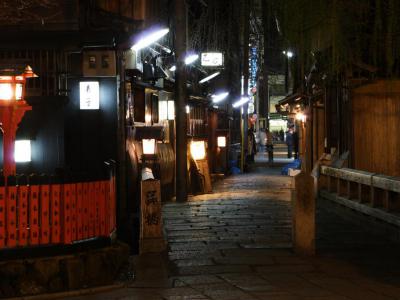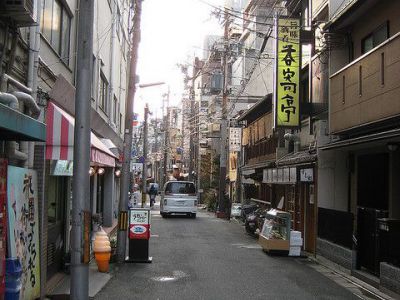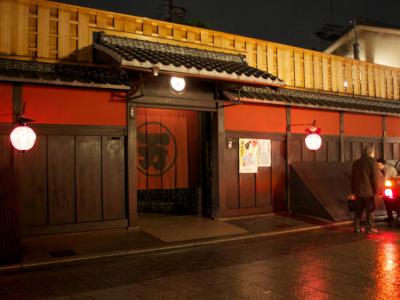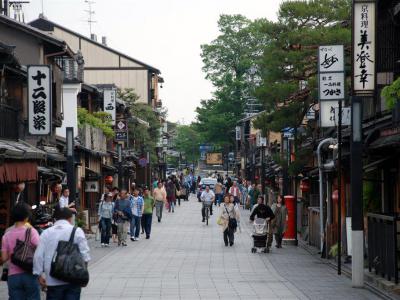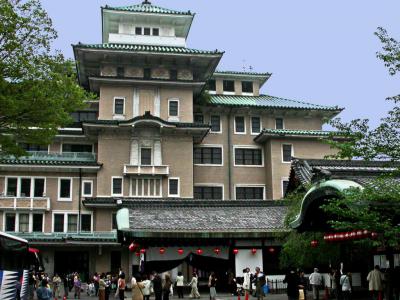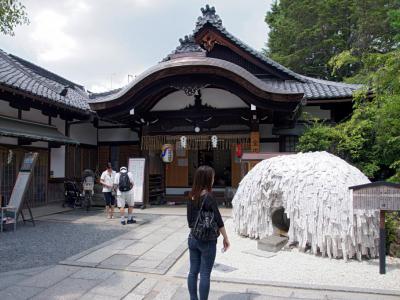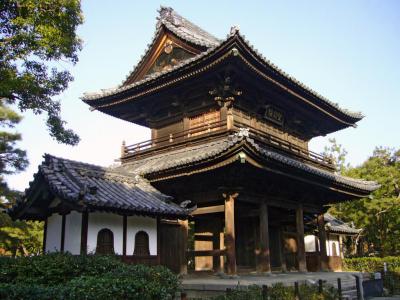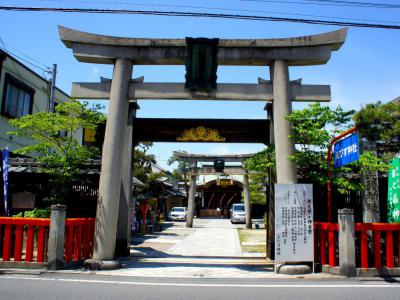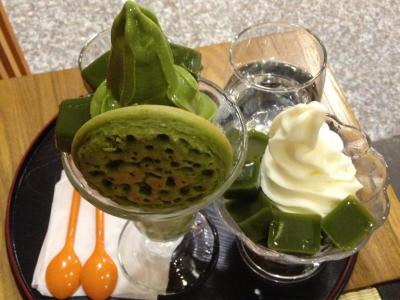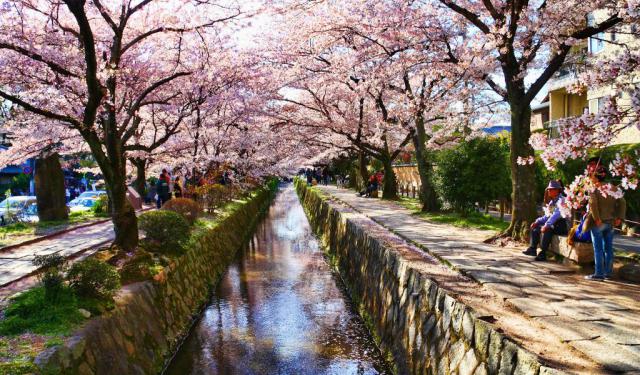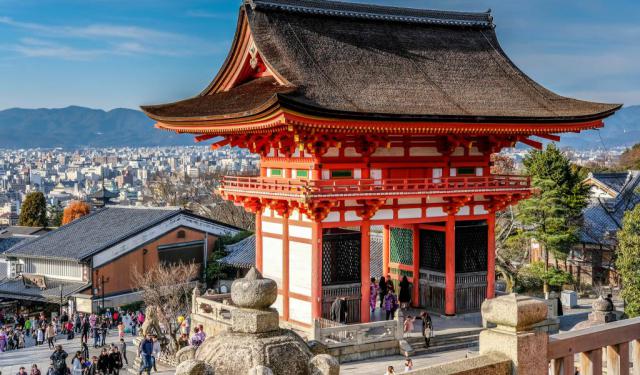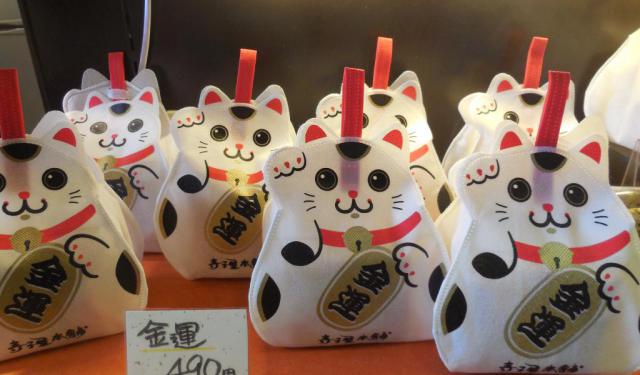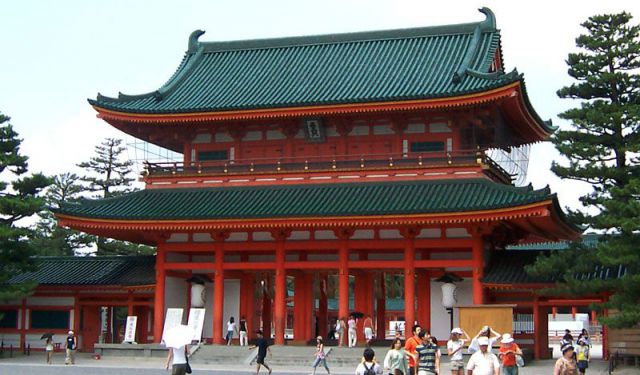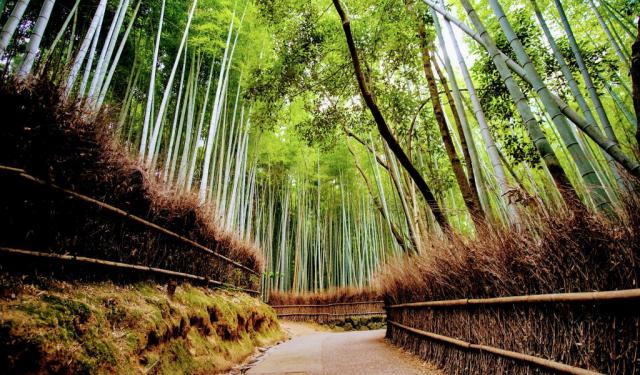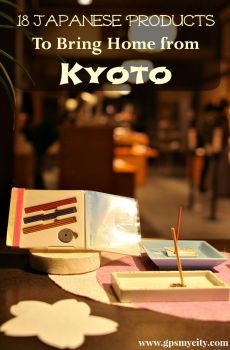Audio Guide: Gion District Walking Tour (Self Guided), Kyoto
Gion, one of Kyoto’s most captivating districts, is deeply rooted in Japan’s cultural heritage. Located in the Higashiyama (the so-called “Eastern Mountain”) neighborhood, its history dates back to the Sengoku period, when it began as a hospitality area for pilgrims visiting Yasaka Shrine. By the late 18th and early 19th centuries, it had evolved into a renowned entertainment quarter, celebrated for its association with geiko (Kyoto’s term for geisha), as well as for the refined traditional arts and teahouses (known as “ochaya”) found here in abundance. Today, Gion retains its historic charm, offering visitors a rare glimpse into the city’s pre-modern elegance, where cobblestone alleys and carefully-preserved machiya wooden architecture continue to set the tone.
One of Gion’s most prominent landmarks is the Minamiza Kabuki Theater, among the oldest in the country, founded as far back as 1610. Reconstructed in 1929, it continues to host seasonal kabuki shows, rich with elaborate costumes and stylized drama. Nearby, Hanamikoji Street provides a quintessential Gion experience with its upscale restaurants and ochaya, where apprentice geisha (called “maiko”) may still be spotted gliding silently to their appointments. The parallel Shirakawa Lane, with its willow-lined canal and cherry blossoms, offers a tranquil alternative, leading to the scenic Tatsumi Bridge and the prestigious Ichiriki Teahouse, famously linked to the tale of the 47 Ronin.
Art and history lovers will find much to admire on Shinmonzen-dori Street, known for its antique shops and galleries. At Gion Corner, short cultural performances introduce visitors to the tea ceremony, ikebana, traditional dance, and puppetry. Religious and spiritual heritage is represented by the Yasui Konpira-gu Shrine, known for its wish-fulfilling stone, and the Kennin-ji Temple, Kyoto’s oldest Zen sanctuary, featuring contemplative gardens and a dramatic twin-dragon ceiling.
The Ebisu-jinja Shrine, dedicated to prosperity, honors the deity of fishermen and merchants; it gets particularly lively in January during the Toka Ebisu Festival. Concluding the journey, the celebrated Saryo Tsujiri Tea House beckons guests with its exquisite matcha offerings, providing an authentic dessert experience with its renowned tea, parfaits, and desserts.
Altogether, Gion encapsulates the essence of Japan, blending the vibrancy of a living cultural area with the reverence of centuries-old tradition. To those who seek to immerse themselves in its historical and artistic legacy, Gion promises an atmospheric journey of beauty, depth, and discovery. Embark on it now and unravel the mysteries of this captivating district in the heart of Kyoto firsthand!
One of Gion’s most prominent landmarks is the Minamiza Kabuki Theater, among the oldest in the country, founded as far back as 1610. Reconstructed in 1929, it continues to host seasonal kabuki shows, rich with elaborate costumes and stylized drama. Nearby, Hanamikoji Street provides a quintessential Gion experience with its upscale restaurants and ochaya, where apprentice geisha (called “maiko”) may still be spotted gliding silently to their appointments. The parallel Shirakawa Lane, with its willow-lined canal and cherry blossoms, offers a tranquil alternative, leading to the scenic Tatsumi Bridge and the prestigious Ichiriki Teahouse, famously linked to the tale of the 47 Ronin.
Art and history lovers will find much to admire on Shinmonzen-dori Street, known for its antique shops and galleries. At Gion Corner, short cultural performances introduce visitors to the tea ceremony, ikebana, traditional dance, and puppetry. Religious and spiritual heritage is represented by the Yasui Konpira-gu Shrine, known for its wish-fulfilling stone, and the Kennin-ji Temple, Kyoto’s oldest Zen sanctuary, featuring contemplative gardens and a dramatic twin-dragon ceiling.
The Ebisu-jinja Shrine, dedicated to prosperity, honors the deity of fishermen and merchants; it gets particularly lively in January during the Toka Ebisu Festival. Concluding the journey, the celebrated Saryo Tsujiri Tea House beckons guests with its exquisite matcha offerings, providing an authentic dessert experience with its renowned tea, parfaits, and desserts.
Altogether, Gion encapsulates the essence of Japan, blending the vibrancy of a living cultural area with the reverence of centuries-old tradition. To those who seek to immerse themselves in its historical and artistic legacy, Gion promises an atmospheric journey of beauty, depth, and discovery. Embark on it now and unravel the mysteries of this captivating district in the heart of Kyoto firsthand!
How it works: Download the app "GPSmyCity: Walks in 1K+ Cities" from Apple App Store or Google Play Store to your mobile phone or tablet. The app turns your mobile device into a personal tour guide and its built-in GPS navigation functions guide you from one tour stop to next. The app works offline, so no data plan is needed when traveling abroad.
Gion District Walking Tour Map
Guide Name: Gion District Walking Tour
Guide Location: Japan » Kyoto (See other walking tours in Kyoto)
Guide Type: Self-guided Walking Tour (Sightseeing)
# of Attractions: 11
Tour Duration: 2 Hour(s)
Travel Distance: 2.8 Km or 1.7 Miles
Author: emma
Sight(s) Featured in This Guide:
Guide Location: Japan » Kyoto (See other walking tours in Kyoto)
Guide Type: Self-guided Walking Tour (Sightseeing)
# of Attractions: 11
Tour Duration: 2 Hour(s)
Travel Distance: 2.8 Km or 1.7 Miles
Author: emma
Sight(s) Featured in This Guide:
- Minamiza Kabuki Theater
- Shirakawa Lane
- Tatsumi Bridge
- Shinmonzen-dori Street
- Ichiriki Teahouse
- Hanamikoji Street
- Gion Corner
- Yasui Konpira-gu Shrine
- Kennin-ji Temple
- Ebisu-jinja Shrine
- Saryo Tsujiri Tea House
1) Minamiza Kabuki Theater
Slide into the southeast corner of Shijo-dori street-just behind a popular noodle shop-and you’ll stumble upon the grand dame of Japanese theater: Minamiza. While it hosts a variety of performances, including the newest forms of live entertainment, truth be told-kabuki is the main character here. We're talking full-throttle drama, wild costumes, and men playing everyone (yes, even the ladies). This colorful, dramatic genre of storytelling has been Kyoto's favorite spectacle since the early 17th century, and somehow, it never got old.
Back in the 1600s, kabuki fever ran wild-there were in total seven theaters around town. The shows were so popular they spilled out into the dry bed of the Kamo River, turning it into Kyoto’s liveliest (and dustiest) hotspot.
Four centuries on, Minamiza is the only survivor of time's relentless march-but still flawless after all these years. While the original stage traces its roots back to the early Edo Period (between 1596 and 1615), the current building was completed only in 1929. In 1996, the theater earned the title of Registered Tangible Cultural Property, and shortly after, was also registered as a Structure of Historical Design in Kyoto. Renovated in 2018, she’s now even shinier, but still very much in her prime.
Tip:
To grasp the performed story in English, make sure to rent audio headsets ($7 apiece) and brace yourself for a three-hour-plus sit-down. Yes, kabuki is a marathon, not a sprint, but you can munch on your snacks during intermission.
And if you fancy souvenirs (like those actor postcards and other theatrical trinkets), grab them before the show or during intermissions, as concession stands close after the curtain falls.
Also, Kabuki is a hot ticket, so book early and expect to shell out $30 to $200, depending on your seat.
And while locals may show up looking like extras from a historical drama (dressing up for kabuki in a kimono is the norm), no one will bat an eye at your jeans-so long as you spare them the facepalm moment and leave your cargo shorts at home...
Back in the 1600s, kabuki fever ran wild-there were in total seven theaters around town. The shows were so popular they spilled out into the dry bed of the Kamo River, turning it into Kyoto’s liveliest (and dustiest) hotspot.
Four centuries on, Minamiza is the only survivor of time's relentless march-but still flawless after all these years. While the original stage traces its roots back to the early Edo Period (between 1596 and 1615), the current building was completed only in 1929. In 1996, the theater earned the title of Registered Tangible Cultural Property, and shortly after, was also registered as a Structure of Historical Design in Kyoto. Renovated in 2018, she’s now even shinier, but still very much in her prime.
Tip:
To grasp the performed story in English, make sure to rent audio headsets ($7 apiece) and brace yourself for a three-hour-plus sit-down. Yes, kabuki is a marathon, not a sprint, but you can munch on your snacks during intermission.
And if you fancy souvenirs (like those actor postcards and other theatrical trinkets), grab them before the show or during intermissions, as concession stands close after the curtain falls.
Also, Kabuki is a hot ticket, so book early and expect to shell out $30 to $200, depending on your seat.
And while locals may show up looking like extras from a historical drama (dressing up for kabuki in a kimono is the norm), no one will bat an eye at your jeans-so long as you spare them the facepalm moment and leave your cargo shorts at home...
2) Shirakawa Lane
Oftentimes, the best way to uncover the charm of a city is to follow your whims and wander down unfamiliar paths, all while keeping your eyes wide open along the way. The historic Shirakawa Lane, cutting through the Gion district alongside the Shirakawa Canal (which is a tributary of the Kamo River), is ideally suited for this style of exploration. Like many thoroughfares in the area, it is flanked by tall, leafy willows and peppered with elegant establishments-traditional eateries and geisha houses-gazing out over the water.
Historically tied to Gion’s geisha culture, the lane traces its origins to the broader development of the area as a pleasure quarter during the Sengoku period (between the mid-15th and the early 17th centuries). Over time, it became associated with Kyoto’s entertainment and artistic traditions.
Unlike the bustling tourist hubs of the city, Shirakawa offers a tranquil escape from the beaten path, away from the main shopping and dining arteries, yet still brimming with culinary delights, largely appealing to those interested in the aesthetic charm and subtle rhythms of traditional Japanese life. Visitors here are treated to a delightful vista, which gets especially magical during cherry blossom season, from late March to early April.
During this period, a saunter along the cobblestones is nothing short of mesmerizing, whether bathed in daylight or illuminated by night. With the canal as a backdrop, the soft lantern glow emanating from the restaurants, machiya houses, and the small Tatsumi-jinja Shrine, complete with the photogenic Tatsumi Bridge nearby, reflecting on the gently flowing water, creates an unforgettable spell.
In addition to this, cultural experiences await in the form of ochaya (teahouses), local cafés, craft shops, and seasonal tea tastings.
Shirakawa’s historical atmosphere has made it a favored backdrop for films and TV dramas, including its notable appearance in Memoirs of a Geisha. Indeed, few places capture Japan's essence quite like it: simple, steeped in history, soothing, and heartwarming. A truly special spot not to be overlooked!
Historically tied to Gion’s geisha culture, the lane traces its origins to the broader development of the area as a pleasure quarter during the Sengoku period (between the mid-15th and the early 17th centuries). Over time, it became associated with Kyoto’s entertainment and artistic traditions.
Unlike the bustling tourist hubs of the city, Shirakawa offers a tranquil escape from the beaten path, away from the main shopping and dining arteries, yet still brimming with culinary delights, largely appealing to those interested in the aesthetic charm and subtle rhythms of traditional Japanese life. Visitors here are treated to a delightful vista, which gets especially magical during cherry blossom season, from late March to early April.
During this period, a saunter along the cobblestones is nothing short of mesmerizing, whether bathed in daylight or illuminated by night. With the canal as a backdrop, the soft lantern glow emanating from the restaurants, machiya houses, and the small Tatsumi-jinja Shrine, complete with the photogenic Tatsumi Bridge nearby, reflecting on the gently flowing water, creates an unforgettable spell.
In addition to this, cultural experiences await in the form of ochaya (teahouses), local cafés, craft shops, and seasonal tea tastings.
Shirakawa’s historical atmosphere has made it a favored backdrop for films and TV dramas, including its notable appearance in Memoirs of a Geisha. Indeed, few places capture Japan's essence quite like it: simple, steeped in history, soothing, and heartwarming. A truly special spot not to be overlooked!
3) Tatsumi Bridge
Before surrendering its waters to the mighty Kamo River, the dainty Shirakawa canal sneaks through Gion like a well-mannered guest who knows how to make an impression. And right where things get photogenic, you'll find Tatsumi Bashi-the largest and most camera-hungry bridge on the block-nestled near the Tatsumi Shrine, in a part of town that until recently was pretty much “locals only” (before Instagram blew its cover), hidden from busy streets and well-trodden tourist paths.
However, due to a scene from the Hollywood movie "Memoirs of a Geisha", featuring Tatsumi Bashi, the bridge has gained considerable fame, attracting many visitors eager to capture its beauty in photographs. And it doesn't really matter that the famous scene was filmed nowhere near Kyoto-the carefully recreated bridge replica was shot on a set near Los Angeles-truth proved no match for cinema magic. Thus, today, Tatsumi Bashi basks in the soft-focus glow of global attention. Attesting to that are the abundance of selfie sticks and the presence of newlywed couples (asserting Tatsumi Bashi's newly-acquired status as a popular spot for wedding photography).
Still, despite its popularity, the bridge sees moderate foot traffic and takes on a truly magical allure. Come on a drizzly day and you’ll see it in its true form: glossy stones and a moody charm straight out of a woodblock print. Nighttime makes it just as impressive, as this place surely knows how to dress for the dark, adorned with glowing red lanterns.
The surrounding streets offer a tempting lineup of riverside shops, bars, and restaurants that seem to have all agreed on a collective pact to keep the whole area impeccably clean-a pure joy to walk around. So, whether you’re out to capture the perfect romantic shot or just here for a serene stroll, Tatsumi Bashi makes sure your visit feels like a gentle step back in time-with just a hint of cinematic déjà vu.
However, due to a scene from the Hollywood movie "Memoirs of a Geisha", featuring Tatsumi Bashi, the bridge has gained considerable fame, attracting many visitors eager to capture its beauty in photographs. And it doesn't really matter that the famous scene was filmed nowhere near Kyoto-the carefully recreated bridge replica was shot on a set near Los Angeles-truth proved no match for cinema magic. Thus, today, Tatsumi Bashi basks in the soft-focus glow of global attention. Attesting to that are the abundance of selfie sticks and the presence of newlywed couples (asserting Tatsumi Bashi's newly-acquired status as a popular spot for wedding photography).
Still, despite its popularity, the bridge sees moderate foot traffic and takes on a truly magical allure. Come on a drizzly day and you’ll see it in its true form: glossy stones and a moody charm straight out of a woodblock print. Nighttime makes it just as impressive, as this place surely knows how to dress for the dark, adorned with glowing red lanterns.
The surrounding streets offer a tempting lineup of riverside shops, bars, and restaurants that seem to have all agreed on a collective pact to keep the whole area impeccably clean-a pure joy to walk around. So, whether you’re out to capture the perfect romantic shot or just here for a serene stroll, Tatsumi Bashi makes sure your visit feels like a gentle step back in time-with just a hint of cinematic déjà vu.
4) Shinmonzen-dori Street
Welcome to Shinmonzen-dori-Gion’s unofficial time machine and Kyoto’s most refined flea market, minus the fleas. Flanked by the equally charming neighboring streets, Furumonzen-dori and Nawate-dori, this area forms the holy trinity of antique hunting in the city. Picture a lineup of two-story wooden townhouses, quietly flaunting their wares like seasoned art dealers who know they’re sitting on centuries of cultural swagger. Inside, you’ll find family-run shops where knowledge is handed down like secret recipes-except the ingredients are ancient scrolls, bronze Buddhas, lacquered boxes, and hand-carved netsuke that probably tell better stories than you do.
Among the scene-stealers here is Kawasaki Fine Arts, an establishment celebrated for its exquisite collection of folding screens ranging from prized antiques of Edo-period elegance to modern eye candy by up-and-coming artists. Next up, Ezoshi tempts collectors with Ukiyo-e prints, including those moody 19th-century Shin Hanga pieces that make you feel like you understand seasonal melancholy. And if you want to sniff out history, Kaori has incense and perfumes for the contemplative nose. Otherwise, swing by Old Art Kanzando, where porcelain and Imari-style pottery share shelf space with ornate hairpins that are so fancy they deserve their own Netflix series.
And if your legs (or your wallet) need a break, there’s even a traditional Ryokan inn tucked into the mix. Here, on select days, you can sip matcha in a candlelit tea ceremony while staring pensively at a rock garden-pretending you’re a wandering poet with excellent taste.
So, whether you're a serious collector or just a curious browser with a fondness for things older than your grandma’s cat, Shinmonzen-dori delivers cultural charm and an enriching experience for all.
Among the scene-stealers here is Kawasaki Fine Arts, an establishment celebrated for its exquisite collection of folding screens ranging from prized antiques of Edo-period elegance to modern eye candy by up-and-coming artists. Next up, Ezoshi tempts collectors with Ukiyo-e prints, including those moody 19th-century Shin Hanga pieces that make you feel like you understand seasonal melancholy. And if you want to sniff out history, Kaori has incense and perfumes for the contemplative nose. Otherwise, swing by Old Art Kanzando, where porcelain and Imari-style pottery share shelf space with ornate hairpins that are so fancy they deserve their own Netflix series.
And if your legs (or your wallet) need a break, there’s even a traditional Ryokan inn tucked into the mix. Here, on select days, you can sip matcha in a candlelit tea ceremony while staring pensively at a rock garden-pretending you’re a wandering poet with excellent taste.
So, whether you're a serious collector or just a curious browser with a fondness for things older than your grandma’s cat, Shinmonzen-dori delivers cultural charm and an enriching experience for all.
5) Ichiriki Teahouse
Let’s set the scene: you're wandering Kyoto’s Gion district, home to the flutter of kimono sleeves, the faint strum of a shamisen (a three-stringed Japanese musical instrument), and the quiet power of secrets whispered behind paper walls. Just off the intersection of Shijo and Hanamikoji, past the rickshaws and Instagram hopefuls, looms the bold red facade of Ichiriki Teahouse-a place so exclusive, you’d have better luck booking tea with a ghost than getting a seat here without a proper introduction.
For over 300 years, Ichiriki hasn’t just been the VIP lounge of geisha entertainment-it’s been a hotbed of historical drama. By day, it hosted Kyoto’s elite in tatami-clad elegance. By night-at least in the 19th century-it became a shadowy rendezvous point for samurai rebels who were less into sipping tea and more into overthrowing governments. That’s right: plots to topple the shogunate were brewed here alongside the matcha.
But rewind another century, and things get even juicier. Enter the 47 Ronin, Japan’s most famous revenge squad. The whole saga starts with a nobleman, Asano, who lost his temper while at Edo Castle, trying to sword-slap a smug court official named Kira. Bad idea... For his troubles, Asano was ordered to commit ritual suicide ('seppuku'), thus leaving his loyal samurai jobless-and furious.
Now masterless, these ronin scattered into obscurity… or so it seemed. Their leader, Oishi Kuranosuke, put on an Oscar-worthy performance, faking a midlife crisis here at Ichiriki. Think less revenge, more sake-fueled gambling binge. But it was all a smokescreen. After two years of pretending to be the world’s most irresponsible ex-samurai, Oishi and the gang struck, exacting their revenge on Kira, who lost his head-literally-thus fulfilling their solemn vow. As for the ronin themselves, despite facing the ultimate consequence of ritual suicide, their valor and sacrifice elevated them to legendary status, immortalizing both their tale and the legacy of Ichiriki teahouse for generations to come.
So, whenever you stroll past Ichiriki, remember: it’s not just a fancy teahouse. It’s the quiet epicenter of loyalty, espionage, and centuries-old revenge plots. You know… typical Gion vibes.
For over 300 years, Ichiriki hasn’t just been the VIP lounge of geisha entertainment-it’s been a hotbed of historical drama. By day, it hosted Kyoto’s elite in tatami-clad elegance. By night-at least in the 19th century-it became a shadowy rendezvous point for samurai rebels who were less into sipping tea and more into overthrowing governments. That’s right: plots to topple the shogunate were brewed here alongside the matcha.
But rewind another century, and things get even juicier. Enter the 47 Ronin, Japan’s most famous revenge squad. The whole saga starts with a nobleman, Asano, who lost his temper while at Edo Castle, trying to sword-slap a smug court official named Kira. Bad idea... For his troubles, Asano was ordered to commit ritual suicide ('seppuku'), thus leaving his loyal samurai jobless-and furious.
Now masterless, these ronin scattered into obscurity… or so it seemed. Their leader, Oishi Kuranosuke, put on an Oscar-worthy performance, faking a midlife crisis here at Ichiriki. Think less revenge, more sake-fueled gambling binge. But it was all a smokescreen. After two years of pretending to be the world’s most irresponsible ex-samurai, Oishi and the gang struck, exacting their revenge on Kira, who lost his head-literally-thus fulfilling their solemn vow. As for the ronin themselves, despite facing the ultimate consequence of ritual suicide, their valor and sacrifice elevated them to legendary status, immortalizing both their tale and the legacy of Ichiriki teahouse for generations to come.
So, whenever you stroll past Ichiriki, remember: it’s not just a fancy teahouse. It’s the quiet epicenter of loyalty, espionage, and centuries-old revenge plots. You know… typical Gion vibes.
6) Hanamikoji Street
Hanamikoji, or "Blossom Viewing Lane", is Kyoto’s very own runway for geisha, gourmets, and people with exquisite taste in woodwork. Just a short stroll east of Gion Shijo Station, this lane isn’t so much a street as it is a living postcard-lined with those classic wooden machiya townhouses that look like they’ve time-traveled straight out of the Edo period, with no intention of modernizing.
Yes, it’s touristy. And yes, you’ll be dodging selfie sticks. But it’s also undeniably gorgeous, with the narrow alleyways whispering secrets, the occasional pagoda peeking through tiled rooftops, and if luck is on your side, a fleeting flash of silk and white makeup-one of Gion’s elusive geiko or maiko slipping between appointments. Behind those noren-draped entrances and softly glowing lanterns are Kyoto’s most exclusive teahouses, where a reservation often requires not just wealth, but lineage-or at least a friend in very high places.
Still, you don’t need to be royalty to enjoy the charm. Wander just a hundred meters south of Shijo-dori and you’ll hit Gion Tokuya. Here, anyone-yes, even you-can enjoy matcha and wagashi in a classic tatami room without needing a secret password. Further down, Leica’s boutique and gallery offer an unexpected bonus: world-class photography and a rare peek inside a two-story machiya, no tea ceremony required. And if your stomach is calling, Karyo serves up refined kaiseki lunches in an equally refined setting-deliciously traditional and surprisingly kind to your wallet.
In short, Hanamikoji is Kyoto's perfect blend of heritage, beauty, and bite-sized indulgence.
Yes, it’s touristy. And yes, you’ll be dodging selfie sticks. But it’s also undeniably gorgeous, with the narrow alleyways whispering secrets, the occasional pagoda peeking through tiled rooftops, and if luck is on your side, a fleeting flash of silk and white makeup-one of Gion’s elusive geiko or maiko slipping between appointments. Behind those noren-draped entrances and softly glowing lanterns are Kyoto’s most exclusive teahouses, where a reservation often requires not just wealth, but lineage-or at least a friend in very high places.
Still, you don’t need to be royalty to enjoy the charm. Wander just a hundred meters south of Shijo-dori and you’ll hit Gion Tokuya. Here, anyone-yes, even you-can enjoy matcha and wagashi in a classic tatami room without needing a secret password. Further down, Leica’s boutique and gallery offer an unexpected bonus: world-class photography and a rare peek inside a two-story machiya, no tea ceremony required. And if your stomach is calling, Karyo serves up refined kaiseki lunches in an equally refined setting-deliciously traditional and surprisingly kind to your wallet.
In short, Hanamikoji is Kyoto's perfect blend of heritage, beauty, and bite-sized indulgence.
7) Gion Corner
Some say, a visit to Gion Corner might seem as unapologetically touristy as wearing socks with sandals. But let’s be honest: it’s also a wildly entertaining crash course in traditional Japanese arts. Think of it as an hour-long extravaganza featuring a mishmash of performances including classical puppetry ('bunraku'), tea ceremonies ('chado'), court music ('gagaku'), flower arranging ('ikebana'), six-stringed harp playing ('koto'), ancient slapstick comedy ('kyogen'), and graceful Kyoto-style dance ('kyomai'). Ultimately, it's like the cultural buffet-served fast, strange, and oddly satisfying.
Yes, it’s tailor-made for out-of-towners, but where else can you sample this much heritage in under 60 minutes without blowing your budget? If your timing’s right, you might even catch the Miyako Odori, a geisha dance showcase in full bloom every April and October. And for those with a taste for the surreal, there’s always bunraku-the original 17th-century-style puppet theater that's like a bizarre love child of Broadway and a marionette convention. Picture a human-sized marionette worked by three very serious puppeteers dressed in black, performing tales of heartbreak and honor with the gravitas of Shakespeare and the logistics of a synchronized swimming team.
It's weird, it's captivating, and just like kabuki, it's got that UNESCO stamp of cultural approval. And if nothing else, it’ll give you something to talk about besides how good the matcha parfait was. So, go ahead, suspend your disbelief, indulge your inner art snob, and catch a show. Your inner cultural omnivore will thank you later.
Yes, it’s tailor-made for out-of-towners, but where else can you sample this much heritage in under 60 minutes without blowing your budget? If your timing’s right, you might even catch the Miyako Odori, a geisha dance showcase in full bloom every April and October. And for those with a taste for the surreal, there’s always bunraku-the original 17th-century-style puppet theater that's like a bizarre love child of Broadway and a marionette convention. Picture a human-sized marionette worked by three very serious puppeteers dressed in black, performing tales of heartbreak and honor with the gravitas of Shakespeare and the logistics of a synchronized swimming team.
It's weird, it's captivating, and just like kabuki, it's got that UNESCO stamp of cultural approval. And if nothing else, it’ll give you something to talk about besides how good the matcha parfait was. So, go ahead, suspend your disbelief, indulge your inner art snob, and catch a show. Your inner cultural omnivore will thank you later.
8) Yasui Konpira-gu Shrine
In a country blessed with more love shrines than convenience stores, Yasui Konpira-gu manages to steal the show among the young without a problem. What's making it a hit is the unique feature-a rock-but not just any rock. This one’s got a hole in it, a symbolic tool with a reputation for emotional exfoliation. A line of hopeful romantics routinely come here to crawl through this hole to shed their old relationships and welcome new ones.
Here’s how it works: you scribble your name and current romantic wish-be it breakup or hookup-on a piece of paper. Then, in full public view, you squeeze yourself through the peculiarly shaped boulder. The idea is to leave behind your past romantic entanglements on one side, and emerge purified and ready to mingle on the other. A kind of spiritual speed-dating with mild acrobatics. After your ceremonial limbo, you stick your wish-paper to the rock, joining a growing collage of love-fueled desperation and optimism.
The shrine itself has layers. Legend has it that it started as a Buddhist site back in the 7th century AD and then converted to Shintoism, in 1868, when religion in Japan had a government-mandated identity crisis. These days, Yasui Konpira-gu finds itself on the southeastern outskirts of Gion, flanked-ironically enough-by a lineup of love hotels. Like in other shrines, visitors here also leave wooden plaques called "ema", scribbled with heartfelt (and sometimes hilariously blunt) pleas for affection, fortune, or closure, hanging up for the gods to peruse.
But apart from that. Yasui Konpira-gu is also famed for its Kushi Matsuri, a celebration honoring the humble hair ornaments for their loyal service. Geisha grace the occasion; mindful of the saying "hair is a woman's life", they glide through the grounds, giving thanks to combs for their tireless toil. The festival's main event is a dazzling parade showcasing the evolution of women's intricate hairstyles over 1,000 years-proof that while love may be fickle, updos are forever!
Here’s how it works: you scribble your name and current romantic wish-be it breakup or hookup-on a piece of paper. Then, in full public view, you squeeze yourself through the peculiarly shaped boulder. The idea is to leave behind your past romantic entanglements on one side, and emerge purified and ready to mingle on the other. A kind of spiritual speed-dating with mild acrobatics. After your ceremonial limbo, you stick your wish-paper to the rock, joining a growing collage of love-fueled desperation and optimism.
The shrine itself has layers. Legend has it that it started as a Buddhist site back in the 7th century AD and then converted to Shintoism, in 1868, when religion in Japan had a government-mandated identity crisis. These days, Yasui Konpira-gu finds itself on the southeastern outskirts of Gion, flanked-ironically enough-by a lineup of love hotels. Like in other shrines, visitors here also leave wooden plaques called "ema", scribbled with heartfelt (and sometimes hilariously blunt) pleas for affection, fortune, or closure, hanging up for the gods to peruse.
But apart from that. Yasui Konpira-gu is also famed for its Kushi Matsuri, a celebration honoring the humble hair ornaments for their loyal service. Geisha grace the occasion; mindful of the saying "hair is a woman's life", they glide through the grounds, giving thanks to combs for their tireless toil. The festival's main event is a dazzling parade showcasing the evolution of women's intricate hairstyles over 1,000 years-proof that while love may be fickle, updos are forever!
9) Kennin-ji Temple
Kennin-ji might not clinch the title for "Most Jaw-Dropping Zen Monastery" in Kyoto, but it's a goldmine for Japanese art lovers. Conveniently situated in Gion, it's Kyoto's oldest Zen temple-well, kind of. Like many wooden temples in the area, it's had its fair share of fiery mishaps, so the current building is a mere 250 years old. Following a Chinese-inspired setup, the central axis starts from the Messengers Gate in the south, leading through the Sanmon Gate and Lecture Hall to the Abbot's Quarters.
Back in the day, way back in 1202, a monk named Yōsai decided to shake things up and brought back the Rinzai Zen teaching from his adventures in China. And he didn't just bring back Zen, but tea as well, pitching it as a cure-all potion and a handy tool for meditation marathons.
Kennin-ji once was like the Disneyland of Zen, with 53 subtemples spread across its grounds. Nowadays, they're down to 14, but don't let that fool you-this place is still loaded: rock gardens, tea houses, and paintings. Unfortunately, the temple's most prized possession, "The Wind and Thunder Gods" painting, is kept at the Kyoto National Museum, but hey, they've got a good replica to make up for it.
And let's not forget the Lecture Hall, where the ceiling doubles as a canvas for a gigantic dragon mural. Yup, Zen folks believe it's there to keep the bad vibes away and help you find your Zen zone. It's so massive that folks sometimes have to lie flat on their backs just to take it all in. Trust us, it's one of those "pinch-me-I'm-in-Kyoto" moments-you wouldn't want to miss it!
Back in the day, way back in 1202, a monk named Yōsai decided to shake things up and brought back the Rinzai Zen teaching from his adventures in China. And he didn't just bring back Zen, but tea as well, pitching it as a cure-all potion and a handy tool for meditation marathons.
Kennin-ji once was like the Disneyland of Zen, with 53 subtemples spread across its grounds. Nowadays, they're down to 14, but don't let that fool you-this place is still loaded: rock gardens, tea houses, and paintings. Unfortunately, the temple's most prized possession, "The Wind and Thunder Gods" painting, is kept at the Kyoto National Museum, but hey, they've got a good replica to make up for it.
And let's not forget the Lecture Hall, where the ceiling doubles as a canvas for a gigantic dragon mural. Yup, Zen folks believe it's there to keep the bad vibes away and help you find your Zen zone. It's so massive that folks sometimes have to lie flat on their backs just to take it all in. Trust us, it's one of those "pinch-me-I'm-in-Kyoto" moments-you wouldn't want to miss it!
10) Ebisu-jinja Shrine
Ebisu-jinja is a quaint Shinto shrine, but not your average Shinto shrine. It’s the spiritual stomping ground of Japan’s most cheerful deity, Ebisu, the only homegrown member of Japan's Seven Gods of Fortune and Prosperity. While his divine colleagues migrated from places like China and India, Ebisu proudly keeps things local. You’ll spot this cheery lad gracing the shrine's surroundings, beaming from stone carvings, souvenirs, and various trinkets. Always depicted with a hearty laugh, he's usually wielding a fishing rod in one hand and a big ol’ red bream in the other. Why a fish? Because in Japan, nothing says “party” like a celebratory sea bream.
Now, Ebisu’s origin story wasn’t all smiles and sashimi but one of resilience and unlucky beginnings. According to medieval lore, he arrived in this world with severe deformities-so much so that his own parents abandoned him, setting him adrift in a boat made of reeds. Ouch...
But the baby didn’t sink! He floated straight into the arms of a kind-hearted fisherman who raised him as his own. Despite the rocky start and physical challenges, Ebisu's indomitable spirit never wavered, and his grin became a beacon of hope. He's now revered as the god of good fortune and the patron of fishermen, workers, and children-a divine underdog who turned hardship into heroism with little more than grit and good vibes.
And just when you thought the story couldn’t get more dramatic, enter Yōsai, the founder of nearby Kennin-ji Temple. Legend has it that during his tempestuous sea voyage back from China, he found himself tossed around in a storm. Desperate for a lifeline, he called on-but not a sailor or a monk-he called on Ebisu. And miraculously enough, just like clockwork, the sea calmed down. Grateful for his deliverance and probably a little waterlogged, Yōsai built a shrine in Ebisu’s honor. That’s right-here, Shinto meets Buddhism in a harmonious blend of religious reverence, where Shintoist and Buddhist rituals are often intertwined in daily practice. This beautiful act of spiritual teamwork underscores the inclusive approach, the kind of which only Japan can pull off.
Now, Ebisu’s origin story wasn’t all smiles and sashimi but one of resilience and unlucky beginnings. According to medieval lore, he arrived in this world with severe deformities-so much so that his own parents abandoned him, setting him adrift in a boat made of reeds. Ouch...
But the baby didn’t sink! He floated straight into the arms of a kind-hearted fisherman who raised him as his own. Despite the rocky start and physical challenges, Ebisu's indomitable spirit never wavered, and his grin became a beacon of hope. He's now revered as the god of good fortune and the patron of fishermen, workers, and children-a divine underdog who turned hardship into heroism with little more than grit and good vibes.
And just when you thought the story couldn’t get more dramatic, enter Yōsai, the founder of nearby Kennin-ji Temple. Legend has it that during his tempestuous sea voyage back from China, he found himself tossed around in a storm. Desperate for a lifeline, he called on-but not a sailor or a monk-he called on Ebisu. And miraculously enough, just like clockwork, the sea calmed down. Grateful for his deliverance and probably a little waterlogged, Yōsai built a shrine in Ebisu’s honor. That’s right-here, Shinto meets Buddhism in a harmonious blend of religious reverence, where Shintoist and Buddhist rituals are often intertwined in daily practice. This beautiful act of spiritual teamwork underscores the inclusive approach, the kind of which only Japan can pull off.
11) Saryo Tsujiri Tea House
If your Kyoto adventure doesn’t end with a spoonful of matcha parfait, ask yourself-did you even go to Kyoto? For an authentic Kyoto dessert experience, follow the locals' lead and make a beeline for Saryo Tsujiri, a top-notch spot in Gion renowned for its matcha tea, parfaits, and desserts that are a must-try at least once!
Now, don’t be fooled by its discreet location. Despite being somewhat tucked away amidst souvenir shops, its popularity is unmistakable, attesting to which are the long queues of mostly Japanese schoolgirls, aunties, and dessert disciples snaking up the store's stairs and spilling onto the street-even on weekdays. But fear not, the line moves fast and the wait is well worth it; plus, there's more seating available upstairs than you’d think.
Now, the ground floor is where temptation begins-a deliciously tantalizing showroom of treats, from ice cream and tea samplers to delectable matcha-infused sweets, perfect for souvenirs or a pre-dessert indulgence. But the real show starts when you ascend to the café above. It’s cozy, casual, and dishing out matcha parfaits that come stacked with all the local greatest hits. Kyoto residents are avid parfait enthusiasts, and this place puts a unique spin on this delicacy using domestic ingredients.
Among other local favorites is the Tokusen Tsujiri, a decadent creation featuring green tea sherbet, mochi, red bean paste, vanilla ice cream, Japanese cake, whipped cream, and nuts-a true sweetness overload! During the warmer months, from April to September, indulge in the refreshing Matcha Kakigori shaved ice, or explore other cold and warm dessert options.
Tips:
The English menu comes with photos, so ordering is a breeze-just point, nod, consume, and indulge. If opting for ice cream, devour those mochi balls quickly to prevent them from freezing up next to the ice cream and turning into rock-solid nuggets. You can then take your cone and stroll to Kawabata Street for a riverside moment of green tea bliss, where Matcha meet zen...
Now, don’t be fooled by its discreet location. Despite being somewhat tucked away amidst souvenir shops, its popularity is unmistakable, attesting to which are the long queues of mostly Japanese schoolgirls, aunties, and dessert disciples snaking up the store's stairs and spilling onto the street-even on weekdays. But fear not, the line moves fast and the wait is well worth it; plus, there's more seating available upstairs than you’d think.
Now, the ground floor is where temptation begins-a deliciously tantalizing showroom of treats, from ice cream and tea samplers to delectable matcha-infused sweets, perfect for souvenirs or a pre-dessert indulgence. But the real show starts when you ascend to the café above. It’s cozy, casual, and dishing out matcha parfaits that come stacked with all the local greatest hits. Kyoto residents are avid parfait enthusiasts, and this place puts a unique spin on this delicacy using domestic ingredients.
Among other local favorites is the Tokusen Tsujiri, a decadent creation featuring green tea sherbet, mochi, red bean paste, vanilla ice cream, Japanese cake, whipped cream, and nuts-a true sweetness overload! During the warmer months, from April to September, indulge in the refreshing Matcha Kakigori shaved ice, or explore other cold and warm dessert options.
Tips:
The English menu comes with photos, so ordering is a breeze-just point, nod, consume, and indulge. If opting for ice cream, devour those mochi balls quickly to prevent them from freezing up next to the ice cream and turning into rock-solid nuggets. You can then take your cone and stroll to Kawabata Street for a riverside moment of green tea bliss, where Matcha meet zen...
Walking Tours in Kyoto, Japan
Create Your Own Walk in Kyoto
Creating your own self-guided walk in Kyoto is easy and fun. Choose the city attractions that you want to see and a walk route map will be created just for you. You can even set your hotel as the start point of the walk.
Walk on Philosopher's Path
Looking for a scenic walk with a side of existential pondering in Kyoto, you're inevitably bound to end up on the Philosopher’s Path. Winding its way for about two kilometers along the leafy canal that carries water from Lake Biwa to the foothills, this picturesque walking trail once served as the thinking route of Nishida Kitaro. Back in the first half of the 20th century, the famed... view more
Tour Duration: 2 Hour(s)
Travel Distance: 2.6 Km or 1.6 Miles
Tour Duration: 2 Hour(s)
Travel Distance: 2.6 Km or 1.6 Miles
Higashiyama Walking Tour
It'd be fair to say that Kyoto is a theme park for lovers of history, religion, and all things deeply, unmistakably Japanese. If so, Higashiyama Ward, with its long lines, can easily be recognized as its star attraction. Tucked along the city’s eastern edge-hence its poetic name translated as “Eastern Mountain”-this district is where Kyoto flaunts its heritage like a geisha in full... view more
Tour Duration: 1 Hour(s)
Travel Distance: 2.6 Km or 1.6 Miles
Tour Duration: 1 Hour(s)
Travel Distance: 2.6 Km or 1.6 Miles
Kyoto Shopping and Food Tour
The cultural capital of Japan, Kyoto is just as famous as a shopper’s paradise and, without a doubt, the best place in the country to buy traditional and modern Japanese goods. Souvenirs, food, bargains, and various “one-of-a-kind items” are all up for grabs here.
In addition to its shopping scene, Kyoto boasts a rich culinary heritage, from Michelin-starred restaurants to humble street... view more
Tour Duration: 1 Hour(s)
Travel Distance: 2.0 Km or 1.2 Miles
In addition to its shopping scene, Kyoto boasts a rich culinary heritage, from Michelin-starred restaurants to humble street... view more
Tour Duration: 1 Hour(s)
Travel Distance: 2.0 Km or 1.2 Miles
Imperial Kyoto Walking Tour
Kyoto served as Japan’s imperial capital for over 1,000 years, from 794 to 1869, beginning with Emperor Kanmu’s relocation of his court to Heian-kyō (which is Kyoto’s former name). Though political power eventually shifted to the shogunate and later to Tokyo, Kyoto remained the cultural and symbolic heart of Japan. Its long association with the imperial court helped shape it into a refined... view more
Tour Duration: 2 Hour(s)
Travel Distance: 4.1 Km or 2.5 Miles
Tour Duration: 2 Hour(s)
Travel Distance: 4.1 Km or 2.5 Miles
Arashiyama and Bamboo Grove Walking Tour
The Arashiyama district of Kyoto is slightly out of the way for tourists, but that means you can enjoy it more comfortably.
Undoubtedly, the most popular attraction here is the iconic Bamboo Grove, a mesmerizing forest of towering bamboo stalks that sway gently in the breeze, creating an ethereal atmosphere. This serene setting is a must-visit for travelers seeking tranquility amidst... view more
Tour Duration: 2 Hour(s)
Travel Distance: 3.4 Km or 2.1 Miles
Undoubtedly, the most popular attraction here is the iconic Bamboo Grove, a mesmerizing forest of towering bamboo stalks that sway gently in the breeze, creating an ethereal atmosphere. This serene setting is a must-visit for travelers seeking tranquility amidst... view more
Tour Duration: 2 Hour(s)
Travel Distance: 3.4 Km or 2.1 Miles
Useful Travel Guides for Planning Your Trip
18 Japanese Products To Bring Home from Kyoto
The old capital of Japan, the city of Kyoto has once again been the talk of the world lately, thanks to the bestselling "Memoirs of a Geisha" book and the namesake Hollywood blockbuster movie. Renowned for its impeccable craftsmanship, Japan has so much to amaze a foreign eye with. Many of...
The Most Popular Cities
/ view all
